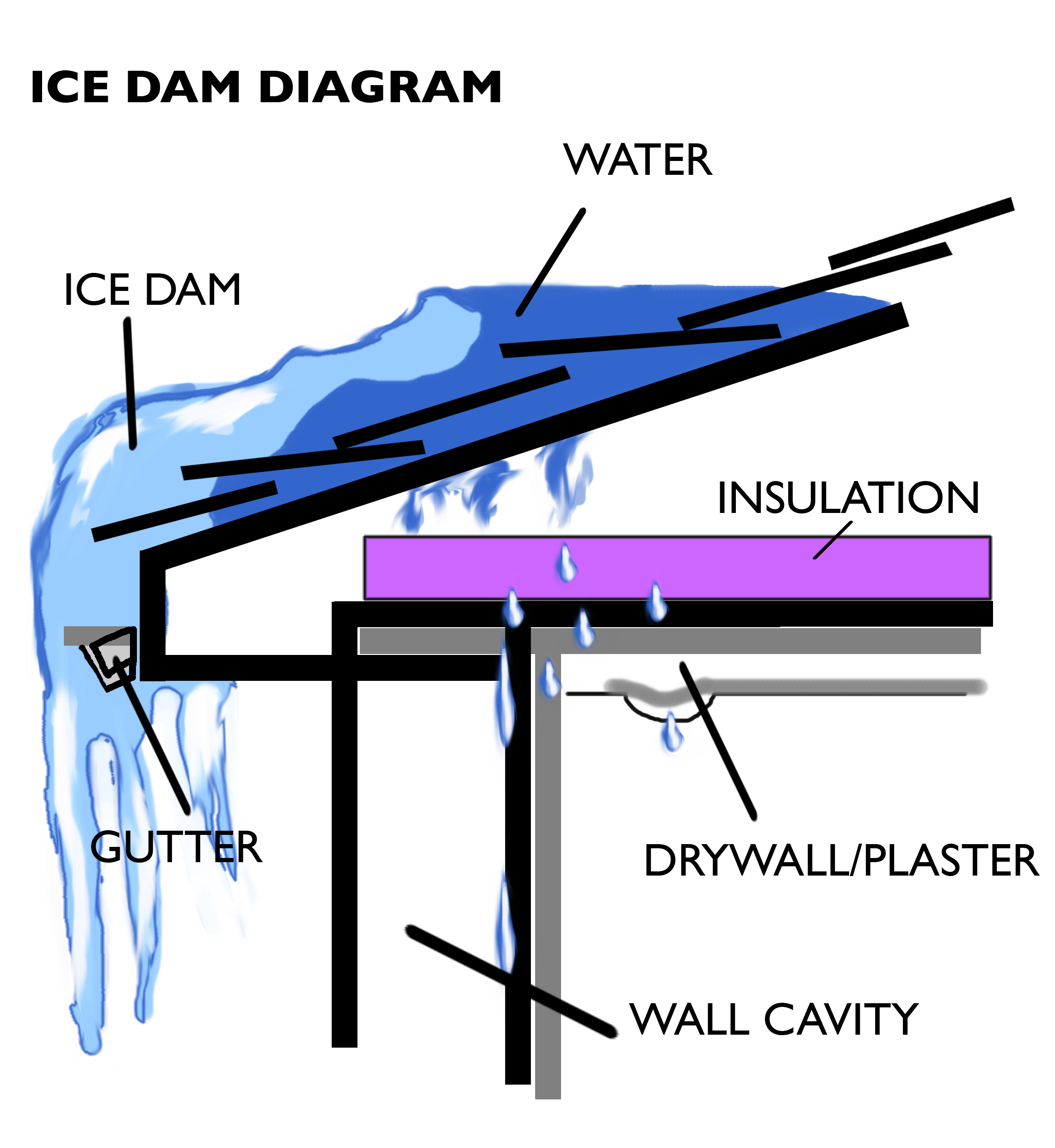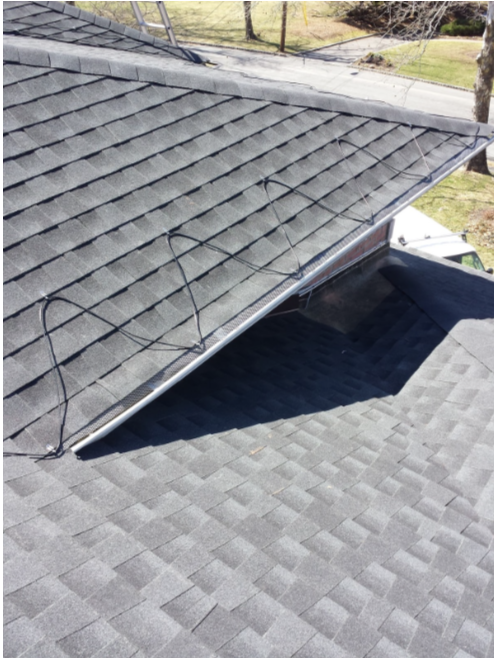During the winter your attic should be as cold as the air outside!
Five Things Are Required For an Ice Dam to Form:
- snow
- heat to melt the snow
- cold to refreeze the melted snow into solid ice
- inadequate house insulation
- poor ventilation
Ice dams can form when as little as 1 or 2 inches of snow accumulates on a roof.
Ice dams are the result of heat radiating up through your roof. In the winter this heat warms the snow on your roof and causes it to melt. As the water runs down the roof towards the edges of your roof, it will start to cool off and re-freeze. As this cycle occurs daily, the ice dam will continually build up.

The build up creates a wall of ice (the dam) and the melting water runs down the roof, hits the dam and starts to create a puddle of water. Depending on the surrounding temperature, if the water starts to freeze it will contribute to a growing ice dam on your roof. If the water has not frozen yet, standing water will look for a means of escape, hence it will leak under the shingles and if you have no ice and water shield, the water will seep onto the wood deck of the roof. At this point your roof deck can become saturated with water and the water will leak into your house through the seams in the wood and nail holes.
The reason ice-dams form along the roof’s lower edge, usually above the overhang, is straight-forward. The upper roof surface (toward the ridgeline) is at a temperature that is above freezing. And the lower part of the roof surface (along the eaves) is below freezing. The upper roof surface is located directly above the living space. Heat lost from the house warms this section of the roof, melting snow in this area. During periods of sub-freezing temperature the lower regions of the roof deck remain at sub-freezing ambient temperatures. Roof overhangs are not warmed by indoor heat-loss.
Deep snow and cold temperatures increase the likelihood and size of ice dams. Every inch of snow that accumulates on the roof’s surface insulates the roof deck a little more, trapping more indoor heat beneath the roof deck and warming the roof sheathing.
Another problem is the gutters. Gutters can become clogged with leaves and sticks that create barriers so the water cannot run out. In the winter, clogged gutters easily freeze over and often is the starting place for ice dams. Additionally, ice clogged gutters become very heavy causing gutters to pull off the house and potentially damage the fascia.
In the North NJ area, it is code to have ice and water shield at the first three feet of the roof. However, in some cases, even one course of ice and water shield may not be enough, especially if the house is not properly insulated.
LONG TERM SOLUTIONS
Insulation: A permanent solution should be sought to eliminate ice dams. First, install the proper insulation so that the heat inside your home stays there and does not leak into your attic. In many cases homes will for the most part have adequate ventilation, but heat “leaks” into the attic through entrances, heat vents, even with ceiling recessed lighting.
First make sure any entrance is well insulated on the attic side. Doors, pull down stairs and whole house fans need to have insulation installed so that heat cannot seep through into the attic.
Heating ducts running through the attic also need to be well insulated as well as recessed lighting. Use extreme caution with insulating recessed lighting. Unlike the other examples, recessed lighting gives off a great deal of heat. Placing the insulation too close to the fixture can potentially cause a fire. If recessed lighting is a problem, call an electrician and/or an insulating professional to recommend a safe, proper way to insulate your lighting.
Heat escaping not only causes ice dams, but also raises your heating costs.
Ventilation: During the winter your attic should be as cold as the air outside.
Your house needs to breathe. Proper ventilation allows for heat and moisture to be removed from your attic to keep it cool and dry.
Every house needs to have ventilation in a couple of key spots, starting with soffit vents and a ridge vent. These allow for a flow of air from the bottom eaves of the roof up through the ridge at the peak.
What McCollum Roofing & Siding Can Do For You
De-Icing Cable: Pre-Snow: De-icing Cable is a powerful tool in preventing ice and snow from building up on the roof which halts proper drainage through your gutter system, leading to possible leaks. The cable is a coated electrical wire that can be installed on eave & valley (if needed) to prevent ice buildup in your gutters.
Snow & Ice Removal: If you already have ice damming, McCollum Roofing & Siding is experienced with snow and ice removal from your roof and gutters. Call to set up an estimate as soon as damming occurs to prevent any further damage. The process and problem areas will be explained to you.
* We do not suggest that homeowners to any chopping on their own. You can get seriously hurt and cause damage to your roof. Leave it to professionals, especially ones that have the experience.



